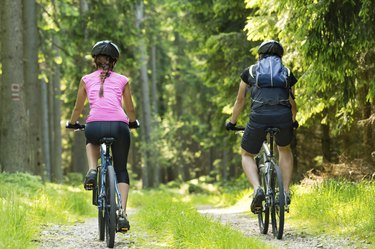
Look at any professional cyclist and you'll notice what USA Cycling's endurance director calls his "strange" shape: bulging quads and big butt with a small waist. The best cyclists use both their quads and glutes, or butt muscles, to provide power with each pedal stroke. You can't, however, just mentally direct your butt muscles to provide greater activation during your rides – you have to work hard in the gym and on the bike to maximize the use of your gluteus maximus during cycling.
Glute Contribution
Video of the Day
The largest muscle of the buttocks, the gluteus maximus, causes your hips to extend and therefore gives you power to press down during each pedal stroke. The smaller gluteus medius and minimus, which make up the hip abductors, allow for outward rotation and lateral movement of the hips. These smaller glute muscles do not offer power during the pedal stroke, but do provide stability.
Video of the Day
Not Everyone Uses Them
Trainer and sports nutritionist Matt Fitzgerald points out that less proficient cyclists activate their quads more during rides and lose out on the potential power that the gluteus maximus can provide. Riders who want to improve their performance should do targeted training for the glutes to make them stronger so that these muscles can contribute significantly to pedaling power.
You’ll Pay for Neglect
Although the gluteus medius and minimus don't provide a lot of power to your pedal stroke, they do help stabilize your pelvis as you sit, or stand, on your bike. When these smaller glute muscles are weak, you are vulnerable to knee injury – which can sideline you from the saddle. "Bicycling" recommends you also do targeted exercises to keep the gluteus minimus and medius strong to reduce your risk of injury on or off the bike.
Recommended Exercises
To strengthen the glutes, Fitzgerald recommends a combination of resistance and plyometric, or jumping, exercises. The suitcase deadlift, in which you hold a dumbbell in one hand in front of your thighs and bend your hips and knees to almost touch it to the floor, and the single-leg box jump are examples of glute-strengthening exercises. "Bicycling" suggests exercises such as speed skater drills, in which you laterally jump side to side, and single leg curls using a stability ball to train your gluteus medius and minimus. Do these moves at least twice per week for one or two sets of 15 to 20 repetitions.
Bike Work
Follow each of your resistance training sessions with a ride focused on high-intensity intervals. The ride doesn't have to be long -- 30 minutes or so -- and may be performed outdoors or indoors on a trainer or indoor cycling bike. Sample intervals last 30 to 90 seconds at a very high effort with an equal amount of easy riding between them. As you pedal, focus on the entire pedal stroke, not just hammering down the front using your quadriceps.